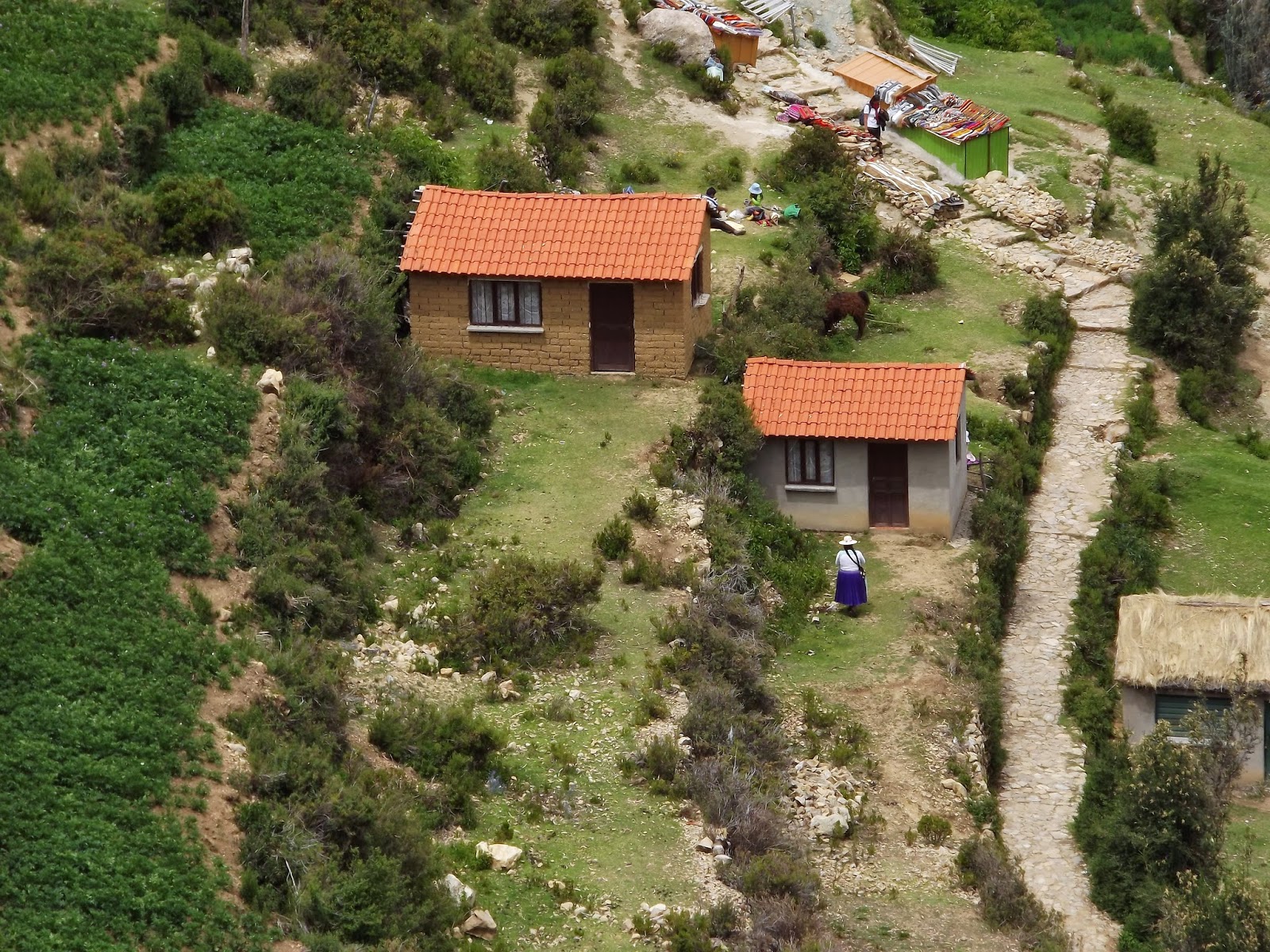Next stop was lovely Taquille Island, about 1 1/2 hours from the floating islands by boat. This was just enough time for the sun to peek out and by the time we arrived it was a beautiful day. Taquille is occupied by about 2200 Quechua-speaking people. It is not a large island, about 1 1/2 by 5 1/2 km but the high point of the island is at over 4000 metres above sea level. Truly breath-taking!
 |
| Welcome to the island |
 |
| Picturesque stone pathways, walls and archways |
 |
| Sheep blend into the rocky landscape |
Taquille Island also has its own unique culture, vastly different from that of the floating islands, and reminiscent of that of Isla del Sol in some respects. The geography of the two islands are similar, steep and rocky, so that certainly has some bearing on it. It was a steep climb up to the top of the island, though nowhere as daunting as Isla del Sol, and with stunning vistas. The path was stone and well cared for, and the island, like most others in the area, is fully terraced for agricultural plots. The island is divided into six sectors and the islanders have a management plan in which about half of the island is farmed in these tiny chacras for 3 years, then is set to rest for 3 years while the other half of the island is then farmed. Taquille and its resources are owned and managed collectively by all the islanders.


There are small flocks of sheep and hobbit-style gates in quaint stone walls. Many of the sheep have colored tassels attached to the wool near their left ears, presumably for identification purposes rather than decoration. There are several stone arches over the pathway, decorated with stone heads representing the mayor and other dignitaries of the island.
 |
| A charming hobbit-sized gate |
 |
| Gate adorned by stone busts of dignitaries |
Partway up we stopped with our group for a pre-planned lunch, which was fresh grilled trout with a rich and tasty quinoa soup to start. A young man in traditional dress demonstrated how to make soap from one of the locally grown plants, and we were told that it is the soap they use for everything because it is natural and non-polluting to their lake. They wash all the wool they shear from their sheep with this soap, as well as their own clothing and judging from the whiteness of the shirts and hats it's effective. All the islanders dress in traditional clothing, and look dignified and colorful at the same time.
 |
| Fresh lake trout for lunch grilled to perfection |
 |
| Making soap to wash clothing and wool |
The people of Taquille marry quite young, around 18 years of age. The men indicate their marital status by the type of hat they wear. Unmarried men and boys wear red and white woven hats, while married ones wear red. The women indicate their marital status by the pompoms on their shawls. The unmarried women have brightly colored large pom-poms on their shawls, while the married ones have ones that are more subdued in color and smaller. In addition to their woven caps, the mayor and other dignitaries wear a brimmed hat that indicates their position in the community.
 |
| An unmarried girl in her shawl with colorful tassels |
 |
| Wearing the red and white hat of an unmarried man |
We lingered over lunch, then hiked up the remaining way to the top of the island, where the plaza is, and where the center of business is located. There is a bell tower, no longer in use, but on three sides of the plaza there are large buildings, one of which houses the artisan's gallery. Knitting on Taquille is strictly a man's occupation, and they are accomplished at it. Boys begin knitting at the age of eight. Wool is spun and dyed by the women, and women also weave beautiful clothing and functional objects, but knitting is done by the men.
 |
| At the plaza atop the island |
 |
| The now defunct but still picturesque bell tower |
 |
| The artisans market |
 |
| Fabrics by Men says the sign. But not just FOR men, happily. |
We did some shopping there for gifts for family and friends then wound our way down the stone path towards the other side of the island where our boat was to be waiting. It was an interesting day, full of riches for the eye. We had learned a little more about another culture, met some new friends and had an excellent workout in the process. One more proof that life is indeed good.
 |
| One last look at our Taquille panorama |
 |
| Fishing boats resting in the harbor |
 |
| Rowing home |
And so concluded our vacation time. We had travelled to Bolivia and southern Peru and had packed a ton of experiences into just over a week. This trip wasn't even in the cards originally, but hey, when opportunity knocks you'd best open the door. Hasta luego mis amigos!































































